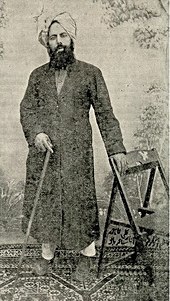Mirza Ghulam Ahmad

Mirza Ghulam Ahmad (Urdu مرزا غلام احمد DMG Mirzā Ġulām Aḥmad; born 13 February 1835 in Qadian; died 26 May 1908 in Lahore) was a British Indian preacher and founder of the Ahmadiyya Movement. He claimed to be the "Mujaddid (Renewer) of the 14th Islamic Century", the "Promised Messiah" (Second Presence of Christ), the Mahdi of the Last Days awaited by Muslims, and a "(Mohammed's subordinate) prophet". He proclaimed that Jesus (Isa ibn Maryam) had survived his crucifixion, emigrated to India, and later died of natural causes in Srinagar, Kashmir, and claimed to appear in the spirit and authority of Jesus. He also proclaimed that Guru Nanak Dev, the founder of Sikhism, had been a Muslim. He also held that Messiah and Imam Mahdi were two titles for the same person.
Preaching the new religious ideas and ideals, he traveled extensively throughout the Indian subcontinent and gained about 400,000 followers by the time of his death. He participated in numerous debates and dialogues with Christian missionaries and Muslim and Hindu leaders and priests. Ghulam Ahmad founded the Ahmadiyya Movement in 1889. According to him, the mission of the Ahmadiyya was to spread Islam in its "original" form.
Mirza Ghulam Ahmad wrote 82 religious books, mostly in Urdu, some in Arabic and Persian. His major work was Barahin-e-Ahmadiyya. They contain the exposition and explanation of the teachings which he claimed to have received from God.

Hadhrat Mirza Ghulam Ahmad (1907)

Mirza Ghulam Ahmad (circa 1898)
Ancestors
Mirza Hadi Beg migrated to India from Persia during the time of the Mughal Emperor Babur. He settled in Punjab and founded a village called Islampur, now Qadian. The Mirza family held influential offices of state during the Mughal rule. At the zenith of their power, their holdings included Qadian and 85 other villages, totalling 12,840 hectares.
With the decline of Mughal rule, the family's sphere of influence and power also declined. By the middle of the 19th century, the land holdings had dwindled to Qadian. Mirza Ghulam Murtaza joined the Maharaja's army. After the consolidation of Sikh rule, five villages were returned to the tribe by the Sikh ruler Maharaja Ranjit Singh. In 1839, the Sikh ruler died and the Sikh Empire began to disintegrate. At the same time, the British extended their sphere of influence into Punjab. Mirza Ghulam Murtaza served the British government as much as he had served the Sikh government. For his services, he later received a pension of 200 rupees.
Life
Mirza Ghulam Ahmad was born on 13 February 1835, the second son of Mirza Ghulam Murtaza (d. 1876) and Chiragh Bibi (d. 1868). His twin sister died a few days after her birth. His father was a chief and the largest landowner in Qadian village. Though he had no riches, he had some servants and a recognized position and authority. Mirza Ghulam Ahmad received private tuition from various teachers.
His first marriage to Hurmat Bibi (1852/53-1891) produced two sons, Mirza Sultan Ahmad (1853-1931) and Mirza Fazal Ahmad (1855-1904). In his second marriage, he married Nusrat Jehan Begum, daughter of Nawab Nasir of Delhi, on 17 November 1884. This marriage produced ten children, five of whom died at an early age:
- Asmat (1886-1891)
- Bashir (1887-1888)
- Mirza Bashir ud-Din Mahmud Ahmad (1889-1965)
- Shokat (1891-1892)
- Mirza Bashir Ahmad (1893-1963)
- Mirza Sharif Ahmad (1895-1961)
- Nawab Mubarka Begum (1897-1977)
- Mirza Mubarak Ahmad (1899-1907)
- Amtul-Nasir (1903-1903)
- Amtul-Hafiz Begum (1904-1987)
Questions and Answers
Q: Who was Mirza Ghulam Ahmad?
A: Mirza Ghulam Ahmad was a 19th-century religious leader who founded the Ahmadiyya movement within Islam.
Q: What did Mirza Ghulam Ahmad believe about his role in Islam?
A: According to Ahmadi doctrine, Mirza Ghulam Ahmad was the last prophet, as well as the Mahdi and the Messiah.
Q: What is the Ahmadiyya movement?
A: The Ahmadiyya movement is a sect within Islam that was founded by Mirza Ghulam Ahmad.
Q: What is the Mujaddid of the 14th Islamic century?
A: The Mujaddid of the 14th Islamic century is the title given to a revered religious figure who is said to have revived and renewed Islam during that time period. According to Ahmadis, Mirza Ghulam Ahmad was the Mujaddid of the 14th century.
Q: When was Mirza Ghulam Ahmad born and when did he die?
A: Mirza Ghulam Ahmad was born on February 13, 1835 and died on May 26, 1908.
Q: What is the significance of Mirza Ghulam Ahmad to the Ahmadiyya movement?
A: Mirza Ghulam Ahmad is considered to be the founder and spiritual leader of the Ahmadiyya movement, and his teachings and writings continue to be a central part of the group's beliefs and practices.
Q: How do Ahmadis view Mirza Ghulam Ahmad's role in Islam compared to other religious figures?
A: Ahmadis believe that Mirza Ghulam Ahmad was the last prophet, as well as the Mahdi and the Messiah, and they hold him in very high regard as a revered religious figure who played a crucial role in the history of Islam.
Search within the encyclopedia